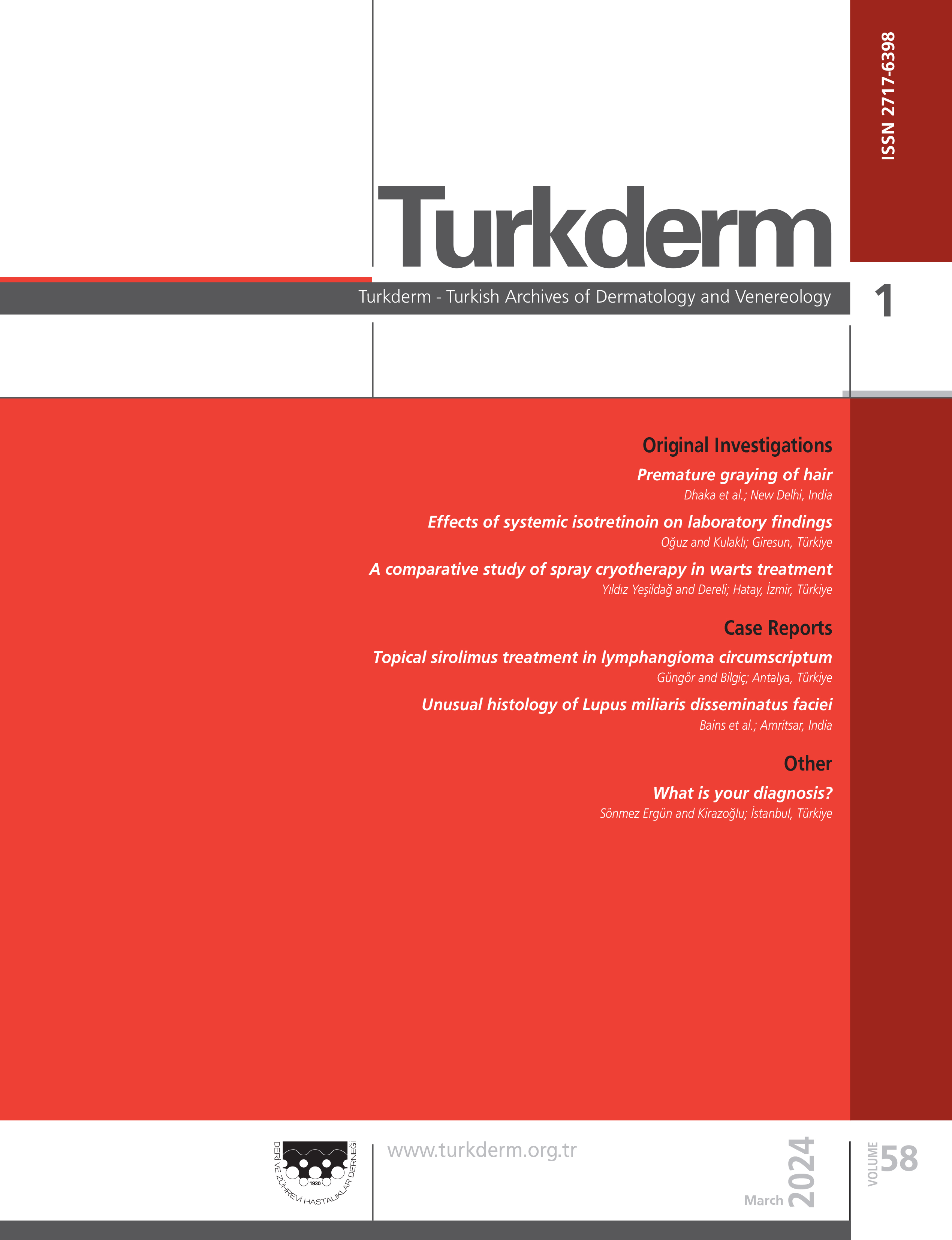Comparison of the Distributions of Seborrheic Dermatitis, Herpes Zoster and Pityriasis Rosea According to Seasons
Tuncer Saçar1, Handan Saçar21Özel Buca Doruk Tıp Merkezi, İzmir, Türkiye2Bornova Sifa Hospital, İzmir, Turkey
Background and Design: The common characteristic of seborrheic dermatitis, herpes zoster and pityriasis rosea is the increase in their incidence in the low weather temperature periods. The aim of this study was to determine the relationships of seborrheic dermatitis, herpes zoster and pityriasis rosea with the months and sessions during the year.
Material and Method: Twenty thousends three hundreds ninety seven patients referred to our dermatology policlinic between December 2006 and December 2009 with 1801 patients being diagnosed as seborrheic dermatitis, herpes zoster or pityriasis rosea were retrospectively analysed from the automation record system. The patients were grouped according to demographic data and diagnosis.
Results: A statistically significant relationship was found between the diseases and the seasons in which they were frequently seen (p<0.001). It was found that 32.5% of seborrheic dermatitis was seen in autumn season, 29.8% of herpes zoster was seen in autumn season, 31.0% of pityriasis rosea was seen in winter season, and 29.1% of all dermatological diseases was seen in winter season. A statistically significant relationship was found between the diseases and the months in which they were frequently seen (p<0.001). It was detected that 12.3% of seborrheic dermatitis was seen in November, 11.5% of herpes zoster was seen in September, 10.7% of pityriasis rosea was seen in January, and 8.21% of all dermatological diseases was seen in February.
Conclusion: Our study results show parallelism with literature knowledge. Seborrheic dermatitis, herpes zoster and pityriasis rosea were seen in most high ratios in autumn and winter seasons. We suggest that the decrease in the environment temperature causes a depression in cellular immune resistance, and this leads to the emergence or relapses of diseases in patients prone to diseases.
Seboreik Dermatit, Herpes Zoster ve Pitriyazis Rozeanın Mevsimlere Göre Dağılımının Karşılaştırılması
Tuncer Saçar1, Handan Saçar21Özel Buca Doruk Tıp Merkezi, İzmir, Türkiye2Bornova Şifa Hastanesi, İzmir, Türkiye
Amaç: Seboreik dermatit, herpes zoster ve pitriyazis rozeanın ortak özellikleri hava ısısının düşük olduğu dönemlerde görülme sıklıklarının artmasıdır. Biz çalışmamızda seboreik dermatit, herpes zoster ve pitriyazis rozeanın yıl içinde aylar ve mevsimler ile olan ilişkilerini saptamayı amaçladık.
Gereç ve Yöntem: Aralık 2006 - Aralık 2009 tarihleri arasında dermatoloji polikliniğimize başvuran 20397 hasta ve seboreik dermatit, herpes zoster ve pitriyazis rozea tanısı almış olan 1801 hasta otomasyon dosya sisteminden retrospektif olarak analiz edildi. Hastalar demografik verilere ve tanılara göre gruplandırıldı.
Bulgular: Hastalıklar ile sık görüldüğü mevsimler arasında istatistiksel olarak anlamlı ilişki tespit edildi (p<0,001). Seboreik dermatit %32,5 oranında sonbahar mevsiminde, herpes zoster %29,8 oranında sonbahar mevsiminde, pitriyazis rozea %31,0 oranında kış mevsiminde, tüm dermatolojik hastalıklar %29,1 oranında kış mevsiminde tespit edildi. Hastalıklar ile sık görüldüğü aylar arasında istatistiksel olarak anlamlı ilişki tespit edildi (p<0,001). Seboreik dermatit %12,3 oranında kasım ayında, herpes zoster %11,5 oranında eylül ayında, pitriyazis rozea %10,7 oranında ocak ayında, tüm dermatolojik hastalıklar %8,21 oranında şubat ayında tespit edildi.
Sonuç: Çalışma sonuçlarımız literatür bilgileri ile paralellik göstermektedir. Seboreik dermatit, herpes zoster, pitriyazis rozea ve tüm dermatolojik hastalıkların görülmesi açısından sonbahar ve kış ayları en yüksek oranda tespit edilmiştir. Ortam ısısının düşmesi hücresel immun direncin deprese olmasına neden olmakta, bunun da hastalıklara yatkın bireylerde hastalıkların ortaya çıkmasına ya da nüksüne neden olduğunu düşünüyoruz.
Corresponding Author: Tuncer Saçar, Türkiye
Manuscript Language: Turkish






















